Starting to write: Old and new beginnings
8 October 2024
My new novel, Love’s Knife, a medieval murder mystery, was published last month. I started writing it 10 years ago during a month-long writing residency in the Pyrenees. It’s been a long time brewing. I just came across a series of blogposts from those weeks of having the initial idea for the novel and am reposting them below.
Now, I am starting again – to write book 2 in the series. Back in 2014, I thought the series would begin in Farrera but after many rewrites, Love’s Knife begins in Toulouse in 1093, when Beatriz de Farrera, my trobairitz sleuth, is 17 years old.
Beatriz and her friends, the deaf maid Anna and Lady Philippa who is the dispossessed heiress of Toulouse, are travelling into the Pyrenees in book 2. No doubt I will use some of the details from my posts below to help me get started with writing the new book.
Love’s Knife ebook or paperback available here: https://www.amazon.co.uk/Loves-Knife-Trobairitz-Sleuth-Book-ebook/dp/B0D1YK2C8G
Cover image shows the view from my writing desk window of the 12th-century chapel of Santa Eulalia in Alendo, on the opposite side of the valley from Farrera.
In Farrera at 1,365 metres above sea level14 October 2014
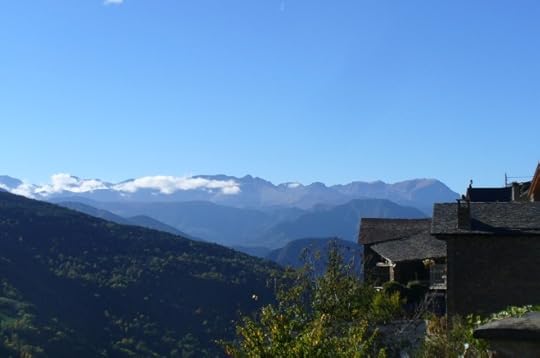
Yesterday I said a temporary goodbye to the river Viaur, swollen by the night’s heavy rain and hailstones, and to the heron who is on the weir every morning outside my tiny house in southern France.
My friend Rob drove me six hours, past Gaillac and Toulouse to the Pyrenees, along the steep sides of deep valleys with a silver ribbon of river below, past ski resorts, and over the Spanish border to the tiny village of Farrera, 1,365m above sea level, in the ancient county of Pallars Sobira in the Catalan Pyrenees. In the darkness we couldn’t see the mountains around us but sensed them as the road wound steeply up and up and round and round on itself.
We arrived to a welcome from the director of the Centre d’Art i Natura, Lluis Llobet. I am spending three weeks here as writer in residence. We sat down for the evening meal with the other artists in residence: Quelic Berga from Barcelona, Tuula Närhinen from Helsinki and Anna Rubio, who lives in Farrera.
Woke to see what a beautiful place I have arrived in. Organised my desk and walked around the valley to the nearby village of Alendo. Belled sheep are jumping along the ridge sounding like a Balinese Gamelan. Two black mules graze in the valley. A tired grasshopper sits on the path. Dark mountain peaks stand proud of brilliant white wisps of cloud in a blue dream of sky. I am fascinated by the drystone wall constructions. The houses have stones jutting out to sit on, rest your basket on, or for the postman to leave a parcel, or there are cubby-holes in the walls for post or lamps or bottles of milk. There is nothing extraneous. These useful extrusions and intrusions are integral to the houses. The rose window of the old church is created with what looks like a cartwheel. Grey and brown slate roofs are like fish scales. Tall, thin poplars in the valley are growing densely and looking like a green sea, waving. The tree-clad mountainside opposite has the occasional autumnal splash, tree tips dipped in intense red.
I am planning to start writing a novel here that I am calling A Morsel of Love’s Bread, and its Knife, which is adapted from a line of poetry by the Troubadour Duke, Guillaume IX of Aquitaine, written in the 11th century. Guillaume’s poetry is a paradox: half of his surviving works are very raunchy and the other half are heartfelt lyrical love songs. He will be one of the characters in my novel.
At dinner we talk about the origins of the Centre d’Art i Natura which opened in 1996. The Pyrenean villages were steadily depopulating during the 20th century. By the 1970s many where empty and abandoned and Farrera itself had only a handful of mostly aging residents. After Franco’s death in 1975 some of the young people from Barcelona and elsewhere started to move out of the cities, seeking a new rural lifestyle living on the land, as they were also doing in the UK, migrating to villages in rural Wales, Cumbria, Northumberland and the Scottish Highlands. Lluis and his wife Ceske were amongst those who moved to Farrera and there were also new inhabitants from Ireland, Bernard Loughlin and his wife Mary, and occasionally their friend Colm Tóibín whose novel The South, is set in Farrera. I’ve borrowed it from the library here to read.
Writing Eyrie16 October 2014
 Dag Peterson’s watercolour of the Cockerel on Farrera’s Bell Tower
Dag Peterson’s watercolour of the Cockerel on Farrera’s Bell TowerTuula Narhinen, Quelic Berga and I spent the first few days here in Casa Ramon and I grew quite fond of my attic writing eyrie but tomorrow we are moving into the newer, purpose built rooms in the Centre which face out across the spectacular view of the valley and mountains. The skylight in my attic room in Casa Ramon has a view straight to the weather vane and bell tower of the church. Quelic is working on an installation combining notions of Google and God. Tuula is flying a camera with a kite but is having trouble finding enough wind or, when there is wind, controlling it in the unpredictable turbulence around the mountains. Every day she climbs to Coll de So, the Pass of Sound, seeking wind and has met with plenty of cows. She is painting the colours of Farrera. I am looking forward to finding out more about their work.
At dinner Lluis and Quelic talk about Catalan independence and history. There has been iron mining in this area for centuries and hence the name of this village. Each night Arnau Llobet cooks an amazing meal for us and his artistry extends beyond the delicious food too. Tonight he has scattered pomegranates and red autumn leaves on the table so that it is like picknicking in a forest glade. He was up early climbing above 2000 feet to gather the mushrooms that make part of our meal this evening. He tells us about seeing the shy chamois deer up there.
The future and the past17 October 2014
I am working on two new novels. One is set in the late 11th century and features a female troubadour from this village, Farrera. Most of the action takes place in Toulouse and Poitiers, but there will also be some scenes set here and in Aragon.
The second new novel I am working on is set in the future, in the 23rd century, and engages with climate change and accompanying change on all levels: social, economic, technological. I am especially interested in what the old technologies, lifestyles and means of survival from the past can teach us about the future. At dinner I talk with Ceske about the food that she and Arnau and many Catalans are used to foraging from their environments: mushrooms, fruit, nuts, herbs, and how many city people in the UK and probably many rural ones too no longer have this knowledge for living with the seasonal rhythms.
Fishing in the Library18 October 2014
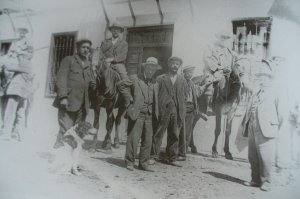 The Prince of Monaco and retainers on a trout fishing expedition in the Pyrenees in 1918
The Prince of Monaco and retainers on a trout fishing expedition in the Pyrenees in 1918A fabulous day in the library reading about Farrera – birds and wildlife, plants and landscape, people. I read about barking deer, boars with their striped piglets, wild cats and tufty eared red squirrels, fields of white Narcissus Poeticus, Tengleman’s Owl, Black Woodpeckers, the Capercaillie and the Lammergeir or Bearded Vulture. I feel like I have arrived now with a better sense of where I am. A smoky sunset on the mountain peaks.
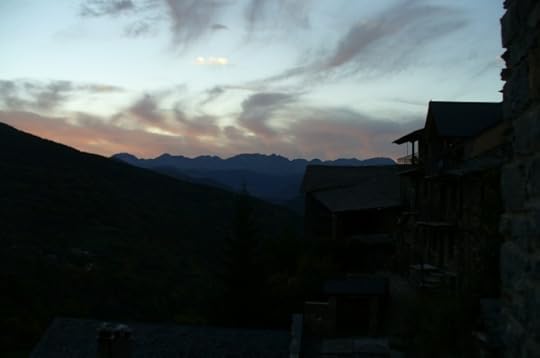 Romanesque
Romanesque1 November 2014
 Sant Pere del Burgal frescos in MNAC, Barcelona
Sant Pere del Burgal frescos in MNAC, Barcelona
 Llucia de la Marca
Llucia de la MarcaWent to Sant Pere del Burgal near Escalo in the Pyrenees a few days ago to see the 11th century frescos in the church by the Master of Pedret.
Below the Holy Family and the saints, Llucia de la Marca is represented. She was the Countess of Pallars Sobira and the sister of the heroine of my first novel, Almodis the Peaceweaver. The originals have been removed for safekeeping to MNAC Museum in Barcelona and the church has very good reproductions in their place. It was good to imagine them in situ and to see the situation of the monastery.
Also visited medieval tombstones in Tirvia which show the deceased persons’ occupations.
 Headstone for a houndsman, Tirvia
Headstone for a houndsman, Tirvia
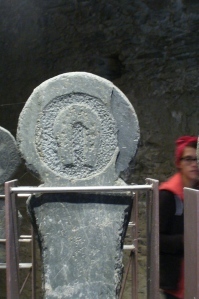 Headstone for a Smith, Tirvia
Headstone for a Smith, Tirvia
 Headstone for a Bellmaker, TirviaThe little river tributaries number more than your eyelashes
Headstone for a Bellmaker, TirviaThe little river tributaries number more than your eyelashesAlso found in the Farrera library.
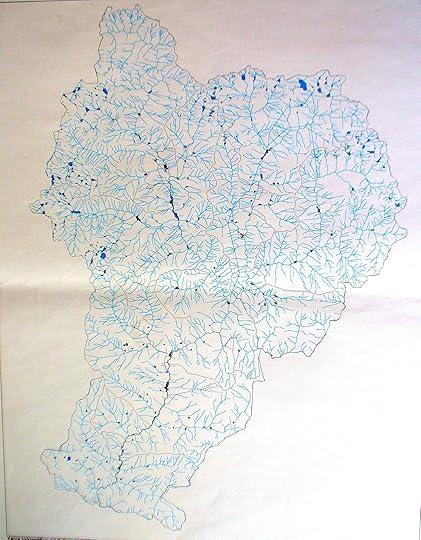 Hydra Map of Pallars Sobira in the Catalan Pyrenees
Hydra Map of Pallars Sobira in the Catalan Pyrenees[The post title is adapted from a poem by Keats.]



